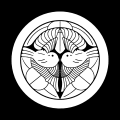
Uesugi Harunori
Uesugi Harunori (上杉 治憲, September 9, 1751 – April 2, 1822) was a Japanese daimyo, the 9th head of the Yonezawa domain (today's Yonezawa and Okitama region), and a descendant of Fujiwara no Yoshikado.[1] Born in Edo, he was the second son of a daimyo of the Akizuki clan, who controlled part of Hyūga Province. His mother was a granddaughter of the fourth head of Yonezawa. His childhood names were "Matsusaburō" (松三郎) and "Naomatsu" (直松). He was adopted by Uesugi Shigesada, then daimyo of Yonezawa, and in 1767 he succeeded Shigesada. After retirement, he adopted the gō, or pen name, Yōzan (鷹山). He was brought at age 16 to the Yonezawa area from a small fief in southern Kyshū as an adopted son of the Uesugi clan.
Today, he is best remembered for his financial reforms, and he is often cited as an example of a good governor of a domain. Yonezawa had been in debt for roughly a hundred years when Harunori took over; Shigesada even considered returning the domain to the shogunate as a last resort. However, he was convinced by his father-in-law, the daimyo of Owari province, to instead resign as daimyo. It was under these conditions that Harunori came to be daimyo of Yonezawa. He introduced strict disciplinary measures, and ordered the execution of several karō (advisors) who opposed his plans. As a result of various measures he took, Yonezawa became fairly prosperous, and did not suffer much from the famine which swept Japan in the Tenmei era (1781-9). For instance the Uesugis chose to keep all their retainers but cut all salaries to one-sixth of their former level. Yozan also cut his own living expenses, wearing cotton clothes instead of silk and having his meals consist of one bowl of soup and one vegetable. He reduced his living allowance from 1500 ryo per year to 209 ryo and the number of maidservants from 50 to nine. He also set policies encouraging new industry such as weaving, pottery and papermaking and encouraged existing enterprises such as paraffin, raw silk and linen. Education was necessary to create the brilliant men required to enrich the country, and he reopened the clan school which had closed down due to financial constraints and invited scholars from Edo to teach. He also established a medical school to teach the latest medical knowledge from Holland. Another policy change ensured adequate water from the mountains for the rice fields by enlisting retainers and samurai to dig irrigation ditches and to repair dikes. Administrative reform and personnel promotion based on merit, not class, eliminated waste and simplified public offices. When Yozan came to power, the total debt of the fief had reached the level of 200,000 ryo; by 1823 the entire amount of the debt had been repaid. In 1830, less than a decade after Harunori's death, Yonezawa was officially declared by the shogunate to be a paragon of a well-governed domain.
He revealed his views on governance and the role of a feudal lord in a letter to his son Haruhiro:
The state (国家, kokka) is inherited from one's ancestors and passed on to one's descendants; it should not be administered selfishly.
The people belong to the state; they should not be administered selfishly.
The lord exists for the sake of the state and the people: the state and the people do not exist for the sake of the lord.[2]
Additionally, his views on self-discipline are well known in Japanese culture:[3]
If you put your mind to it, you can do it;
If you do not, you cannot -- that is true for all things.
When something cannot be done, you are the one to blame
For not putting your heart into it.
See also[]
Notes[]

The emblem (mon) of the Uesugi clan
- ↑ Papinot, Edmund. (2003). Nobiliare du japon -- Sakai, pp. 67; Papinot, Jacques Edmond Joseph. (1906). Dictionnaire d’histoire et de géographie du Japon; retrieved 2012-11-7.
- ↑ Ravinia, Mark. (1995). “State-Building and Political Economy in Early-Modern Japan,” Journal of Asian Studies 54.4.
- ↑ Otani, Monshu Koshin (2009). The Buddha's Wish for the World. American Buddhist Study Center Press. p. 75. ISBN 0-9764594-2-6.
References[]
- Nussbaum, Louis-Frédéric and Käthe Roth. (2005). Japan encyclopedia. Cambridge: Harvard University Press. 10-ISBN 0-674-01753-6; 13-ISBN 978-0-674-01753-5; OCLC 58053128
- Gordenker, Alice. "So, what the heck is that? Mistletoe," Japan Times. December 18, 2007.
- Papinot, Edmund. (1906) Dictionnaire d'histoire et de géographie du japon. Tokyo: Librarie Sansaisha...Click link for digitized 1906 Nobiliaire du japon (2003)
- Sansom, George Bailey. (1963). A History of Japan: 1615-1867. Stanford, California: Stanford University Press. 10-ISBN 0-8047-0527-5; 13-ISBN 978-0-8047-0527-1 (cloth)
- Group KAZE (1988). Yamagata: The Other Side of the Mountain Yamagata, Japan: Kurosaka Printing.
The original article can be found at Uesugi Harunori and the edit history here.